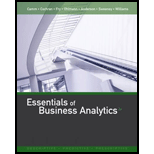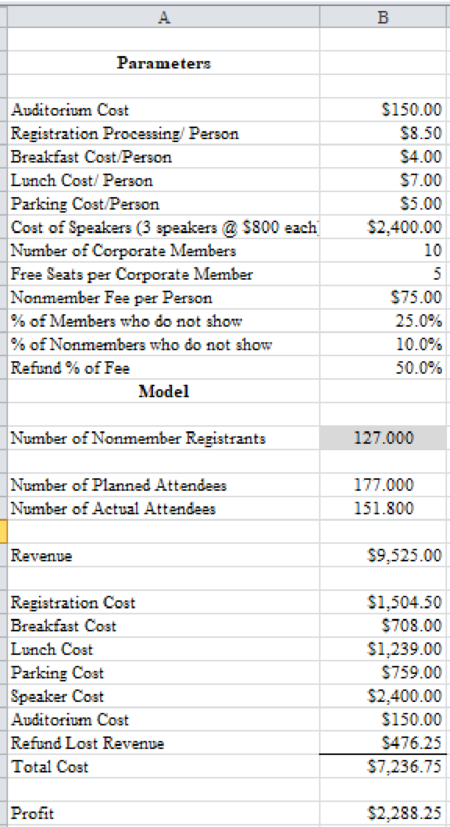
Concept explainers
Consider again the scenario described in Problem 4.
- a. The Center for Business Analytics is considering a refund policy for no-shows. No refund would be given for members who do not attend, but nonmembers who do not attend will be refunded 50% of the price. Extend the model you developed in Problem 4 for the Business Intelligence Symposium to account for the fact that, historically, 25% of members who registered do not show and 10% of registered nonmembers do not attend. The center pays the caterer for breakfast and lunch based on the number of registrants (not the number of attendees). However, the center pays for parking only for those who attend. What is the profit if each corporate member registers their full allotment of tickets and 127 nonmembers register?
- b. Use a two-way data table to show how profit changes as a
function of number of registered nonmembers and the no-show percentage of nonmembers. Vary the number of nonmember registrants from 80 to 160 in increments of 5 and the percentage of nonmember no-shows from 10 to 30% in increments of 2%.
4. The University of Cincinnati Center for Business Analytics is an outreach center that collaborates with industry partners on applied research and continuing education in business analytics. One of the programs offered by the center is a quarterly Business Intelligence Symposium. Each symposium features three speakers on the real-world use of analytics. Each corporate member of the center (there are currently 10) receives five free seats to each symposium. Nonmembers wishing to attend must pay $75 per person. Each attendee receives breakfast, lunch, and free parking. The following are the costs incurred for putting on this

- a. Build a spreadsheet model that calculates a profit or loss based on the number of nonmember registrants.
- b. Use Goal Seek to find the number of nonmember registrants that will make the event break even.
a.
Calculate the profit if each corporate member registers their full allotment of tickets and 127 non-members register.
Answer to Problem 5P
The required profit is $2,288.25.
Explanation of Solution
Calculation:
The EXCEL formulas for calculating the profit is displayed below:

The output for the above mentioned formulas is shown below:

Thus, the required profit is $2,288.25.
b.
Utilise the two-way table to show the change of profit as a function of number of registered non-members and the no-show percentage of non-members using provided information.
Answer to Problem 5P
The two-way data table is obtained as follows:

Explanation of Solution
Step-by-step procedure to create a data table using EXCEL is given below:
- Click on Data>What-If-Analysis.
- Select Data Table from the drop-down list.
- Under Row input cell>click on cell $B$15.
- Under Column input cell>click on cell $B$19.
- Click Ok.
The output for two-way data table is thus obtained.
Want to see more full solutions like this?
Chapter 10 Solutions
Essentials of Business Analytics (MindTap Course List)
 Glencoe Algebra 1, Student Edition, 9780079039897...AlgebraISBN:9780079039897Author:CarterPublisher:McGraw Hill
Glencoe Algebra 1, Student Edition, 9780079039897...AlgebraISBN:9780079039897Author:CarterPublisher:McGraw Hill Big Ideas Math A Bridge To Success Algebra 1: Stu...AlgebraISBN:9781680331141Author:HOUGHTON MIFFLIN HARCOURTPublisher:Houghton Mifflin Harcourt
Big Ideas Math A Bridge To Success Algebra 1: Stu...AlgebraISBN:9781680331141Author:HOUGHTON MIFFLIN HARCOURTPublisher:Houghton Mifflin Harcourt

